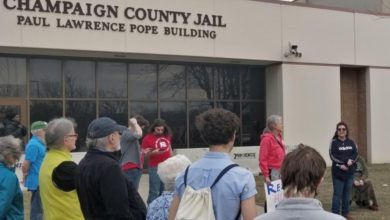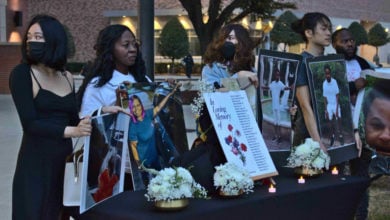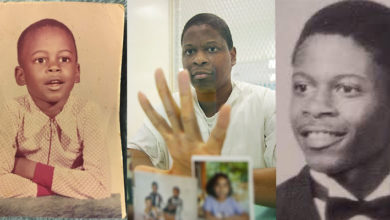On April 6, the International Coalition to Free the Angola Three held a public forum at San Francisco’s Hastings School of the Law to support hunger strikers inside the walls of California prisons. Entitled “The Outer Limits of Solitary Confinement,” the event was co-hosted by the Hastings Race and Poverty Law Journal and the Hastings Chapter of the National Lawyers Guild, and was promoted and attended by members of the Party for Socialism and Liberation.
The forum, attended by over a hundred, was a well-timed expression of public support for the prisoners’ struggle. The first fatality to result from the state-wide hunger strike came on Feb. 2, when 27-year-old Christian Gomez was found dead in his cell in Corcoran prison. Gomez’s fellow-prisoners have widely maintained that they had been screaming at the guards for hours to tell them that Gomez needed immediate help before the prison authorities finally entered Gomez’s cell to remove his body.
The hunger strike began July 1, 2011, among 60 prisoners at Pelican Bay. The prisoners first entered into negotiations with the California Department of Corrections and Rehabilitation on July 20, and began eating again. CDCR made promises to improve the prisoners’ conditions. The prisoners gave CDCR 60 days to show signs of following through before they would call for another strike.
When no improvements were seen after two months, the prisoners called for the hunger strike to be resumed on Sept. 26. Since that time, the strike has spread to as many as 13 different prisons throughout California, with at least 12,000 prisoners having taken part at different times thus far. Some hunger strikers have lost as much as 40 pounds.
Administrative detention is key issue
The hunger strike has taken on many demands, including expanded access to health services, educational opportunities, phone calls, legal services (including access to law libraries), clean clothes and nutritious food. However, the hunger strike’s first and still central demand is an end to solitary confinement and the closing of the Administrative Segregation Units.
The state of California alone, houses more prisoners in solitary confinement than any other nation in the world. Many of those held in long-term solitary confinement are put there for political reasons. Claiming that belonging to leftist or revolutionary prisoners’ associations amounts to membership in a “gang,” prison authorities can place an individual in solitary simply for using terminology in a letter that suggests sympathy to revolutionary causes, such as addressing someone as “comrade.”
Ironically, prisoners accused of violence against other prisoners are given relatively more leeway before being put into solitary than are those who are suspected of gang membership. The ASUs effectively allow the prison authorities to place a prisoner in solitary confinement while they “investigate” whether the prisoner committed an infraction that would “warrant” officially placing the prisoner. The California state prison system is notorious for leaving prisoners in the ASUs for as many as four to five months after the investigations are complete, even when it is determined that the prisoner did not commit the infraction.
Gomez was placed in Corcoran’s ASU, which as of February held about 350 prisoners, while prison officials investigated whether he had been involved in the assault of another inmate. After the investigation determined that Gomez was not involved, he was left in the ASU. It would seem to be this injustice in particular that galvanized Gomez to join 31 other victims of Corcoran’s ASU in the hunger strike starting Jan. 27.
Gomez had also complained to his family that the prison was not providing him with adequate health services. He suffered from high-blood pressure and thyroid and kidney problems that he claimed the prison was not addressing.
Gomez died after only seven days of refusing food. The other Corcoran hunger strikers concluded their strike sometime between Feb. 10 and 12. It is difficult for the public to know the details of the hunger strike as prison authorities can stop prisoners from speaking with journalists. The Corcoran prison authorities claim the hunger strike ended Feb. 9, but the relatives of the strikers insist it was called off later.
The prison coroner told Gomez’s family he had died of a “chemical imbalance, maybe something else,” but assured them that the prison had monitored his health during the time he was on hunger strike. On Feb. 24, the Gomez family called for an investigation into Christian’s death. If the prison authorities were monitoring his health, then why, they ask, did he die so quickly and why, if his health was deteriorating, was he left in his cell instead of being transferred to a medical unit?
On April 3, 400 California prisoners held in long-term solitary confinement petitioned the United Nations to intervene on behalf of all victims of solitary confinement in California, claiming that the nature of their detention amounts to torture and is thus a violation of the United Nations Convention Against Torture and Other Cruel, Inhumane or Degrading Treatment or Punishment, as well as the International Covenant on Civil and Political Rights. Twenty-two prisoners have provided detailed testimony about how they came to be placed in solitary and the effect it has had on their lives. Prisoners are also publicly considering resuming a mass hunger strike this summer.
Forum features Robert King
The International Coalition to Free the Angola Three felt the struggle against solitary confinement needed to be further highlighted to the general public. The San Francisco forum began with two films, “The Grey Box” and “Cruel and Unusual,” that graphically depicted the horrors of solitary.
Interviewed prisoners recalled the ways in which they would lose all sense of time as they saw no natural light for months at a time. Sometimes, the now-freed prisoners recalled, prisoners in solitary would become so desperate to be removed from their cells they would take to extreme self-mutilation, such as cutting off their own testicles, just to be taken elsewhere.
The event included former prisoners attesting to the psychological deterioration, sometimes resulting in suicide, they witnessed in other prisoners in solitary. One of the featured speakers was Robert King, the only one of the Angola Three political prisoners to so far win his freedom. He spoke of the ways in which prison labor resembled slavery. He went on to say that eliminating solitary confinement, which he suffered for 29 years, was a first step towards entirely eliminating the prison-industrial complex.
Another featured speaker was Kiilu Nyasha, another former Black Panther and revolutionary journalist. She recalled how in the late 1960s she and her comrades truly believed they were about to see revolutionary change in the United States. While saying that it has taken longer than she expected, she expressed her belief that a communist revolution could still take place in the U.S. within the next few decades if a properly disciplined revolutionary party presented a truly popular platform for change.
The forum concluded with a poem by former political prisoner Luis “Bato” Talamantez, whose performance included a visceral reference to the horrors of Abu Ghraib. It was a powerful evening, filled with moving expressions of solidarity with the victims of the California Penal System.





